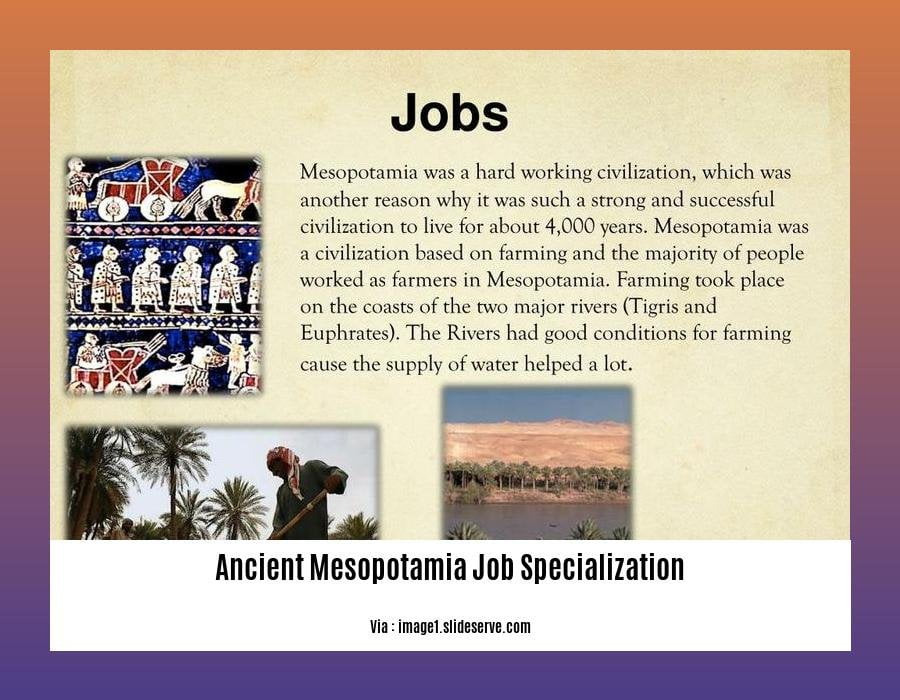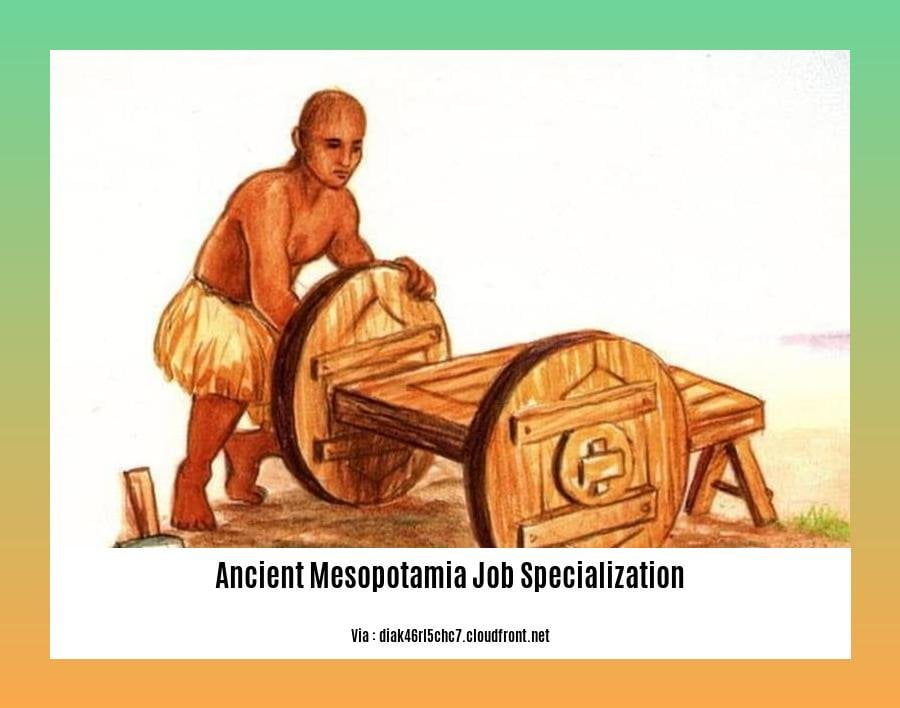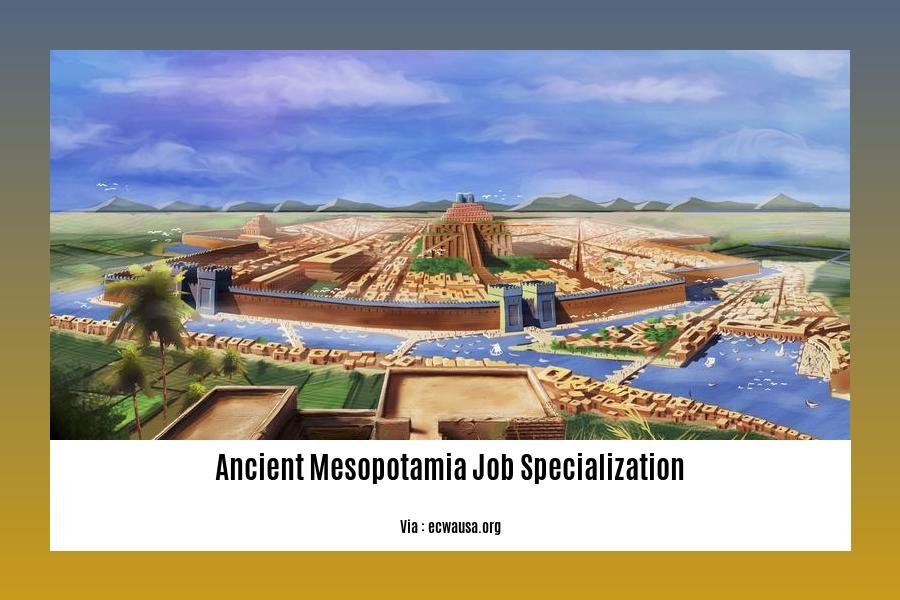Step into the world of ancient Mesopotamia, where a tapestry of intricate social structures and a complex economic system unfolded. The title [Unveiling Job Specialization in Ancient Mesopotamia: The Foundation of a Thriving Civilization] invites us to explore the remarkable achievements of this ancient civilization, as we delve into the specialized occupations that shaped its very core. From skilled artisans and merchants to scribes and administrators, these individuals played a vital role in the development and prosperity of one of the world’s earliest civilizations. Join us as we unravel the mysteries of Mesopotamia, bringing to life the stories of its people and shedding light on the diverse roles they played in building a thriving civilization.
Key Takeaways:
- Job Specialization:
- Essential for the success of ancient Mesopotamia.
Resulted in a variety of specialized occupations.
Agriculture:
- Flourished due to irrigation systems and annual floods.
Farmers cultivated crops providing sustenance.
Textile Industry:
- Thriving industry, offering employment opportunities.
Weavers created essential goods.
Pottery:
- Skilled potters produced both practical and artistic pieces.
Ceramics played a vital role in everyday life.
Diverse Occupations:
- Healers, shoemakers, teachers, priests, and priestesses among specialized workers.
Each occupation contributed to the functioning of society.
Construction and Architecture:
- Skilled workers used bricks to build houses, shops, palaces, and temples.
Construction showcased architectural expertise.
Artisans:
- Skilled artisans crafted a range of goods including pottery, jewelry, clothing, weapons, and tools.
- Their work contributed to the economy and daily life.
Ancient Mesopotamia Job Specialization


In the heart of the ancient world, where the Tigris and Euphrates rivers carved their path through the fertile plains, a remarkable civilization flourished, leaving an indelible mark on history. Ancient Mesopotamia, known as the cradle of civilization, was not only a center of cultural and intellectual achievement but also a hub of economic activity and job specialization.
A Mosaic of Occupations
The tapestry of ancient Mesopotamian society was woven with a diverse array of occupations, each contributing to the overall fabric of the civilization. Farmers, the backbone of the society, tilled the fertile lands, utilizing irrigation systems to ensure bountiful harvests. Artisans, with their skilled hands, crafted exquisite pottery, jewelry, and tools, showcasing their mastery over various materials.
Weavers, using looms, transformed threads into intricate textiles, adorning the bodies of the Mesopotamians and adding beauty to their homes. Merchants ventured far and wide, establishing trade routes that connected Mesopotamia with distant lands, exchanging goods and ideas, and fostering cultural exchange.
Specialized Workers
Beyond these essential occupations, ancient Mesopotamia boasted a multitude of specialized workers who played vital roles in maintaining the smooth functioning of society. Healers, with their knowledge of herbs and remedies, tended to the sick and injured, alleviating suffering and preserving life. Scribes, the keepers of records, meticulously documented transactions, laws, and historical events on clay tablets, ensuring that knowledge and information were preserved for posterity.
Temples, the centers of religious and cultural life, were home to a host of specialized personnel. Priests and priestesses led religious ceremonies, connecting the people with the divine and ensuring the favor of the gods. Musicians filled the air with harmonious melodies, accompanying rituals and celebrations, and adding a touch of beauty to everyday life.
The Foundation of a Thriving Civilization
This intricate web of job specialization laid the foundation for the prosperity and longevity of ancient Mesopotamian civilization. The division of labor allowed for increased efficiency and productivity, enabling the society to produce a surplus of goods and services beyond what was necessary for subsistence. This surplus supported a growing population, the development of cities, and the rise of a complex social structure.
Moreover, job specialization fostered the accumulation and dissemination of knowledge and skills. Artisans honed their craft, passing down techniques and innovations from generation to generation, leading to advancements in various fields, from metallurgy to architecture. Scribes, through their meticulous record-keeping, preserved historical and scientific knowledge, contributing to the intellectual legacy of Mesopotamia.
A Legacy of Innovation and Ingenuity
The ancient Mesopotamians left behind a legacy of innovation and ingenuity, much of which can be traced back to their remarkable job specialization. Their advancements in irrigation, mathematics, astronomy, and law have had a profound impact on the development of human civilization.
Today, as we marvel at the ruins of ancient Mesopotamian cities, the artifacts they left behind, and the stories etched on clay tablets, we can only marvel at the ingenuity and organizational prowess of this ancient civilization. Ancient Mesopotamia job specialization stands as a testament to the transformative power of human cooperation and the pursuit of knowledge, a legacy that continues to inspire and inform us to this day.
- Have you heard about the fascinating ancient names for soap that reveal the unique cultural perspectives of different civilizations?
- Discover the captivating ancient nordic symbols that hold profound meanings and represent the rich mythology and heritage of the Norse people.
- Embark on a journey of exploration as you delve into the ancient norse symbols and meanings, gaining insights into the beliefs, customs, and worldview of the ancient Norse society.
Chapter 1 – Technology of Mesopotamia: Specialization of Labor
Key Takeaways:
Specialization of labor played a vital role in the development and thriving of ancient Mesopotamia by fostering expertise, productivity, and economic growth.
The Sumerians, a prominent civilization in Mesopotamia, implemented specialized labor in their city-states, leading to diverse occupations such as weaving, pottery, construction, healing, and teaching.
Technological advancements like irrigation systems and sophisticated writing contributed to job specialization and enhanced efficiency within society.
Specialized labor enabled ancient Mesopotamia to establish a complex societal structure, with individuals excelling in their respective fields and contributing to the overall progress of the civilization.
Mesopotamia’s job specialization laid the foundation for a thriving and prosperous civilization by maximizing resource utilization, facilitating trade, and fostering innovation and creativity among its citizens.
With the rise of civilization in Mesopotamia, the concept of job specialization began to emerge, transforming a simple agrarian society into a complex and interconnected network of diverse occupations. Chapter 1 – Technology of Mesopotamia: Specialization of Labor delves into the intriguing world of ancient Mesopotamia’s job specialization and highlights how it became the cornerstone of their thriving civilization.
The Sumerians, one of the most influential civilizations of Mesopotamia, embraced job specialization within their city-states. As agriculturalists, they meticulously cultivated crops through advanced irrigation techniques, harnessing the annual flooding of the Tigris and Euphrates rivers. This agricultural prowess laid the foundation for a burgeoning population, leading to the establishment of various occupations and industries.
Skilled artisans emerged, producing intricate pottery, finely woven textiles, and elegant jewelry. Construction workers, equipped with bricks, erected houses, temples, and other structures that showcased architectural ingenuity. Merchants facilitated trade, establishing networks that spanned vast distances, bringing in exotic goods and fostering economic growth.
The development of a sophisticated writing system further propelled Mesopotamia’s job specialization. Scribes, the gatekeepers of knowledge, meticulously recorded transactions, laws, and stories on clay tablets. These written records facilitated communication, administration, and the preservation of historical accounts, enhancing societal organization and efficiency.
A division of labor also emerged within Mesopotamia’s religious sphere. Priests and priestesses held significant positions, performing rituals, managing temples, and serving as intermediaries between the divine and mortal realms. Healers, harnessing herbal knowledge and remedies, provided medical care to the community, alleviating suffering and ensuring the well-being of the population.
Mesopotamia’s job specialization didn’t just benefit the elite; it created opportunities for individuals from all walks of life to contribute to society. Commoners, such as farmers, laborers, and craftsmen, played essential roles in maintaining the infrastructure and producing the goods needed for daily life. This societal structure, with individuals excelling in their respective fields, allowed Mesopotamia to flourish and establish a thriving civilization.
The specialization of labor in ancient Mesopotamia was a testament to human ingenuity and adaptability. It paved the way for technological advancements, economic growth, and the rise of intricate societal structures. By harnessing the unique talents and skills of its people, Mesopotamia laid the foundation for one of the world’s earliest and most influential civilizations.
Sources:
Ancient Mesopotamian Jobs and Occupations
Job Specialization and Public Works in Ancient Mesopotamia
FAQ
Q1: How did job specialization contribute to Mesopotamia’s prosperity?
A1: Job specialization allowed for increased efficiency and productivity, leading to economic growth and the accumulation of wealth, which in turn contributed to Mesopotamia’s prosperity.
Q2: What role did irrigation play in agriculture and the overall development of Mesopotamia?
A2: Irrigation techniques, such as the use of canals and levees, were crucial in maximizing agricultural yields and sustaining a large population, which provided the foundation for the development of urban centers and the emergence of complex societies.
Q3: How did the Mesopotamians’ sophisticated writing system aid in job specialization and societal organization?
A3: The development of a sophisticated writing system enabled efficient record-keeping, communication, and the organization of labor, facilitating specialization and the coordination of large-scale projects.
Q4: What were some of the key occupations in ancient Mesopotamia, and how did they contribute to the functioning of the society?
A4: Key occupations in ancient Mesopotamia included farmers, weavers, potters, healers, teachers, priests, and scribes. These specialized workers played vital roles in meeting the needs of the population, from producing food and clothing to providing education, healthcare, and spiritual guidance.
Q5: What were some of the challenges that Mesopotamian workers faced, and how did they overcome them?
A5: Mesopotamian workers faced challenges such as harsh environmental conditions, fluctuating water levels, and political instability. To overcome these challenges, they relied on their ingenuity, cooperation, and adaptation, developing innovative technologies and strategies for managing their resources and mitigating risks.
















